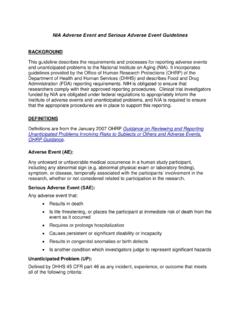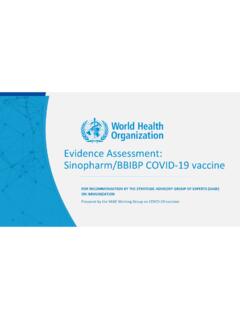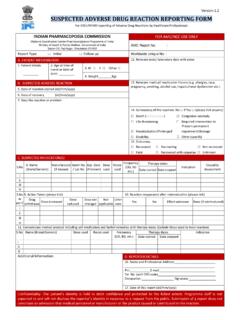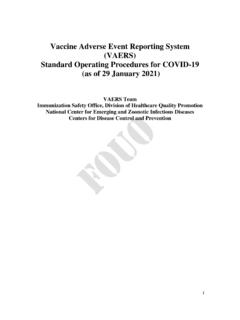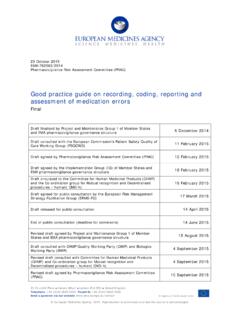Transcription of Guidance on adverse drug reactions - GOV.UK
1 1 Guidance on adverse drug reactions Guidance on adverse drug reactions Contents What is an adverse drug reaction? .. 1 Classification of adverse drug reactions .. 1 How to identify adverse drug reactions .. 2 The burden of adverse drug reactions .. 2 Signal detection .. 3 Data mining .. 3 Signal detection criteria at the MHRA .. 4 Signal assessment .. 4 Signal prioritisation .. 4 Taking regulatory action to minimise risk .. 5 What is an adverse drug reaction? An adverse drug reaction (ADR) is a response to a medicinal product which is noxious and unintended. Response in this context means that a causal relationship between a medicinal product and an adverse event is at least a reasonable possibility. adverse reactions may arise from use of the product within or outside the terms of the marketing authorisation or from occupational exposure. Conditions of use outside the marketing authorisation include off-label use, overdose, misuse, abuse and medication errors.
2 The reaction may be a known side effect of the drug or it may be new and previously unrecognised. The Yellow Card Scheme relies on reporting of suspected ADRs where there is a suspicion that there is a causal relationship between the medicinal product taken and the suspected reaction experienced. Classification of adverse drug reactions adverse drug reactions are frequently classified as type A and type B reactions . An extended version of this classification system is shown here: Type A reactions Type A (augmented) reactions result from an exaggeration of a drug s normal pharmacological actions when given at the usual therapeutic dose and are normally dose-dependent. Examples include respiratory depression with opioids or bleeding with warfarin. Type A reactions also include those that are not directly related to the desired pharmacological action of the drug , for example dry mouth that is associated with tricyclic antidepressants.
3 2 Guidance on adverse drug reactions Type B reactions Type B (bizarre) reactions are novel responses that are not expected from the known pharmacological actions of the drug . These are less common, and so may only be discovered for the first time after a drug has already been made available for general use. Examples include anaphylaxis with penicillin or skin rashes with antibiotics. Type C reactions Type C, or continuing reactions , persist for a relatively long time. An example is osteonecrosis of the jaw with bisphosphonates. Type D reactions Type D, or delayed reactions , become apparent some time after the use of a medicine. The timing of these may make them more difficult to detect. An example is leucopoenia, which can occur up to six weeks after a dose of lomustine. Type E reactions Type E, or end-of-use reactions , are associated with the withdrawal of a medicine.
4 An example is insomnia, anxiety and perceptual disturbances following the withdrawal of benzodiazepines. Other classification schemes have also been proposed, such as DoTS , which takes into account dose-related, time-related and susceptibility factors. How to identify adverse drug reactions Patients may tell you about symptoms they have experienced since taking a new medicine, and it is important to listen to the patient s own concerns regarding their drug therapy. However, as some adverse reactions may not be apparent to the patient, you will need to be alert to the possible occurrence of ADRs. Your own observations and initiative will be vital in this respect, in linking a sign or symptom to either current or previous therapy. (Remember these can include over-the-counter (OTC) drugs and unlicensed herbal remedies). Other things to be alert for include: abnormal clinical measurements ( temperature, pulse, blood pressure, blood glucose, body weight) while on drug therapy abnormal biochemical or haematological laboratory results while on drug therapy.
5 For example, plasma drug concentrations or liver biopsy where drug -induced hepatitis is suspected if new drug therapy is started which may be used to treat the symptoms of an ADR listening to the patient s own concerns regarding drug therapy considering the opinion of a parent if concerning a child The burden of adverse drug reactions adverse drug reactions are frequently serious enough to result in admission to hospital. It is well recognised that adverse drug reactions place a 3 Guidance on adverse drug reactions significant burden on the health service Studies performed in an attempt to quantify this have shown adverse drug reactions account for 1 in 16 hospital admissions, and for 4% of hospital bed capacity. ADRs themselves are also thought to occur in 10-20% of hospital in-patients, and one study found that over 2% of patients admitted with an adverse drug reaction died, approximately of all patients admitted.
6 It is clear that adverse drug reactions adversely affect patients quality of life and can also cause patients to lose confidence in the healthcare system. There is a significant impact through increase costs of patient care and the potential to lengthen hospital stays. adverse drug reactions may also mimic disease, resulting in unnecessary investigations and delays in treatment. Reference: Pirmohamed M et al. adverse drug reactions as cause of admission to hospital: prospective analysis of 18 820 patients. BMJ 2004; 329; 15-19 Signal detection A signal is generally defined as reported information on a possible causal relationship between an adverse event and a drug , the relationship being unknown or incompletely documented previously. Usually more than a single report is required to generate a signal, depending upon the quality of the information. A signal is not a confirmed adverse reaction.
7 The aim of signal detection is to promptly detect any possible unwanted effect associated with a medicine or to detect a change in the pattern or frequency of ADRs already known to be associated with a drug . Data mining Every new ADR report received could potentially contribute to a new signal. In the past, each report was individually assessed to decide if it did indeed contribute to a new signal, but due to the large volume of ADR reports received an automated process is used to help identify a signal. Automated signal detection applies statistical methods that help to focus resources on drug -reaction combinations which require fuller investigation. The ultimate aim is to detect possible drug safety issues as soon as possible so that prompt action can be taken to protect public health. At the MHRA, ADRs reported to the Yellow Card Scheme are rapidly entered onto a database so they are available for signal detection as early as possible.
8 Each week, all drug -reaction combinations in the database are statistically analysed and each combination is assigned a disproportionality score . This disproportionality score is used to identify drug -reaction combinations that have been reported unusually frequently compared to the background of other drug -reaction combinations in the database. drug -reaction combinations which meet defined criteria are then assessed by a group of scientists, 4 Guidance on adverse drug reactions physicians and pharmacists to determine if the signal is likely to be a real medicine-related concern. Signal detection criteria at the MHRA Our criteria for selecting signals for further assessment with established medicines are different from those for medicines under additional monitoring (black triangle medicines). For medicines assigned a black triangle, all reports are assessed regardless of the disproportionality score as the adverse reaction profiles for these medicines have not been fully established.
9 Just a single case report might represent an important safety signal. For established (or non-black triangle) medicines the MHRA select signals for further analysis which meet a set of criteria. These criteria include, for example, all ADRs which occur in children or any which involve a fatality. The criteria are constantly refined and validated to ensure that important signals are selected for further analysis. Signal assessment Once a signal has been identified, it is assessed further by a group of scientists and physicians for the likelihood of a causal relationship between the drug and reaction, and to identify possible risk factors contributing to the reaction, for example, age, underlying disease, and genetic susceptibility. The MHRA considers the risk of a newly-identified adverse reaction to a particular medicine in the context of its overall side effect profile, and compare this profile with those of other medicines used to treat the same conditions.
10 The benefit of the medicine in terms of its efficacy, the condition it is used to treat, and the target patient population are also considered. In addition to data from the Yellow Card Scheme, the MHRA evaluates data from a variety of other sources such including epidemiological studies, published and unpublished data, including regular safety updates supplied by pharmaceutical companies, information from other regulatory authorities and worldwide databases and the Clinical Practice Research Datalink. Signal prioritisation Once a signal has been identified and assessed to be a true adverse effect, it is prioritised using two further statistical methods which help recommend the course of action to take. Impact analysis indicates the impact of the signal through the strength of evidence and the implications for public health. A second tool that takes into account factors that include public perception of the issue and Agency obligations is used to prioritise the signal and define the timeline for completing a full investigation and take necessary action.










